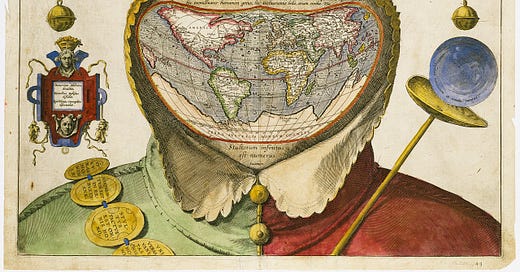In researching the earlier Divine Fool Archetype entry, I came across this curiosity from the National Maritime Museum, Royal Museums Greenwich, London.
The map itself is based on cartographer Abraham Ortelius’ iconic oval projection map of the world, “Typus Orbis Terrarum,” of 1570 - it was published in Ortelius’ Theatrum Orbis Terrarum, the first atlas. The conceit of having a world map in place of the face of a fool came from a 1575 woodcut by Jean de Fourmont; the creator in this case hasn’t been identified, except for the pseudonymic hint within: Epicthonius Cosmopolites.
Here, The Divine Fool Archetype encompasses a foolish framing of the world as we know it (or as it was known at the time of printing); its mainstream 16th century European cultural outlook inflected by religion - ridicule combined with lament at the vanity of earthly aspirations and the folly of humankind.
Its Latin inscriptions are unrelenting in sighs and derision, aside perhaps from Nosce Te Ipsum at the top, “Know thyself,” as originally from the Greek maxim thought to have been carved in the forecourt of the Temple of Apollo at Delphi.
Across the cap’s brow: O caput ellebore dignum / “O head, deserving of a dose of hellebore” (poisonous herb)
On the cap's ears: Auriculas asini quis non habet / “Who doesn’t have donkey ears?” - ascribed to Lucius Annaeus Cornutus, 1st Century AD Roman stoic philosopher, written in defense of Nero.
Ahh, those donkeys - recurring asses, often fig-eating, which figure in several legends of real-life killing jokes, historic people said to have actually died of laughter.
Immediately above the map: Hic est mundi punctus et materia gloriae nostrae, hic sedes, hic honores gerimus, hic exercemus imperia, hic opes cupimus, hic tumultuatur humanum genus, hic instauramus bella, etiam civica. / “This is the point of the world, and this is the substance of our glory, here is its throne, here we seek honors and empire and covet wealth, and throw humanity into tumult, and re-start wars, even civil ones.” - Pliny the Elder, Natural History (book 2, chapter 72)
Below the map, as if in explanation of the above lamentation: Stultorum infinitus est et numerus / “The number of fools is infinite” - Ecclesiastes 1:15
Can’t argue with that.
Plaque on the left: Democritus Abderites deridebat, Heraclites Ephesius deflebat, Epichthonius Cosmopolites deformabat / (of the world) “Democritus of Abdera derided it,” “Heraclitus of Ephesus wept over it,” “Epicthonius Cosmopolites deformed it”
Heraclitus! You know I love the name drop. Then we have Epicthonius Cosmopolites not merely depicting, but deforming the world in what might be a self-referential, waggish, brag. Robert Burton refers to this Fool’s Cap Map of the World in The Anatomy of Melancholy (1621) and assumes Epicthonius Cosmopolites is the signature of its creator.
On the bauble at the top of the jester’s staff on the right is another quote from Ecclesiastes (1:2): Vanitas vanitatum et omnia vanitas / “Vanity of vanities, all is vanity”
The Biblically in vain, or simply, the in vain - the Satanic or secular futile - fits with Killing Joke or Joker-level archetypal absurdity, looming of that grotesque senseless glee. What’s truly cracking up when the devil gets you to laugh?
Threaded disks on the Jester’s shoulder on the left: O curas hominum / “Oh, the cares of humanity”; O quantum est in rebus inane / “Oh, how empty are the things of this world” - opening lines of A. Persius Flaccus’ Satires (friend of Cornutus)
Stultus factus est omnis homo / “All men are stupid” - Jeremiah 10:14
Universa vanitas omnis homo / “Everything is vanity for everyone” - Psalm 39:6
Surely, the Jester archetype as negation shakes its bells here, in vigorous overall religious/humanitarian complaint.
Yet, especially with contemporary Anthropocene sensibility informing appreciation, it would be appropriate to perform an antic somersault or backflip of interpretation - in keeping with the clear buoyancy the map-maker takes in its depiction. It’s certainly a zesty denunciation of earthly life! High spirits and cleverness in facing the world in all its vanity, in all its foolishness, all its violence - to the degree of good-humored affirmation. Imperfect humanity, imperfect knowledge: what else can you expect but universal folly? Nevertheless, embrace the world: blind faith is holy. Again, as before, from Killing Joke to Divine Fool. Paradoxically, cap and bells are worldly wisdom and higher truth.
Magickal Activation: Be Merry
I’m joking. Or am I? Caper, cavort with the world as it is; dance with foolishness in a mad whirl. Decide: take the world as it is and, if you are accepting what is in full, there’s a chance for what could be in all dreamed-of possibility. Wait! Isn’t this risking quiescence? Besides, spiritual discipline is a bore and too much earnestness is - truly - ludicrous. Reach for a star and trip in your curly-toed boots. Jingle your sing-song Nosce Te Ipsum, Nosce Mundum, Amor Fati. Probably only a fool would recommend embracing this fool world, the shitshow status quo, this omnishambles. Or a trickster.






